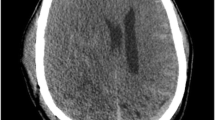Summary
The authors report on two cases of post-traumatic subdural hygroma that were encountered in young adults. Serial computed tomograms were taken immediately following trauma and for more than 4 weeks thereafter. In the case of a 28-year-old man with a skull fracture, an initial CT scan revealed a thin crescentic subdural collection in the right frontal area. A successive CT scan on the 36th postoperative day revealed developed subdural hygroma, and the CSF-like fluid was surgically evacuated. In the second case, involving an 18-year-old man, a very thin bifrontal subdural collection was found on the initial CT scan, and on the 15th post-traumatic day CT scan demonstrated a bifrontal subdural hygroma. No surgical treatment was carried out, and the follow-up CT scan on the 29th post-traumatic day demonstrated no change in size. The two young patients were slightly symptomatic during the period involved, and the repeat unenchanced CT scans showed subdural lesions of less than brain density, even in the chronic stage.
Similar content being viewed by others
References
Cornell SH, Chiu LC, Christie JH (1978) Diagnosis of extracerebral fluid collections by computed tomography. AJR 131: 107–110
French BN, Cobb III CA, Corkill G, Youmans JR (1978) Delayed evolution of posttraumatic subdural hygroma. Surg Neurol 9: 145–148
Hoff J, Bates E, Barnes B, Glickman M, Margolis T (1973) Traumatic subdural hygroma. J Trauma 13:870–876
John JNSt, Dila C (1981) Traumatic subdural hygroma in adults. Neurosurgery 9: 621–626
Kishore PRS, Lipper MH, Domingues da Silva AA, Gudeman SK, Abbas SA (1980) Delayed sequelae of head injury. Comput Tomogr 4:287–295
Naffziger HC (1924) Subdural fluid accumulations following head injury. JAMA 82: 1751–1752
Oka H, Motomochi M, Suzuki Y, Ando K (1972) Subdural hygroma after head injury: a review of 26 cases. Acta Neurochir (Wien) 26:265–273
Payr E (1916) Meningitis serosa bei und nach Schädelverletzungen (Traumatica). Med Klin 12: 841–846
Scotti G, Terburugge K, Melançon D, Bélanger G (1977) Evaluation of the age of subdural hematomas by computerized tomography. J Neurosurg 47: 311–315
Stone JL, Lang RGR, Sugar O, Moody RA (1981) Traumatic subdural hygroma. Neurosurgery 8: 542–550
Todorow S, Happe M (1981) Das traumatische subdurale Hygrom: ein Beitrag zur Klinik und Pathogenese. Neurochirurgia (Stuttg) 24:131–136
Wycis HT (1945) Subdural hygroma: a report of seven cases. J Neurosurg 2: 340–357
Yamada H, Watanabe T, Murata S, Shibui S, Nihei H, Kohno T, Itoh T (1980) Development process of chronic subdural collections of fluid based on CT scan findings. Surg Neurol 13: 441–448
Author information
Authors and Affiliations
Rights and permissions
About this article
Cite this article
Masuzawa, T., Kumagai, M. & Sato, F. Computed tomographic evolution of post-traumatic subdural hygroma in young adults. Neuroradiology 26, 245–248 (1984). https://doi.org/10.1007/BF00342423
Received:
Issue Date:
DOI: https://doi.org/10.1007/BF00342423




